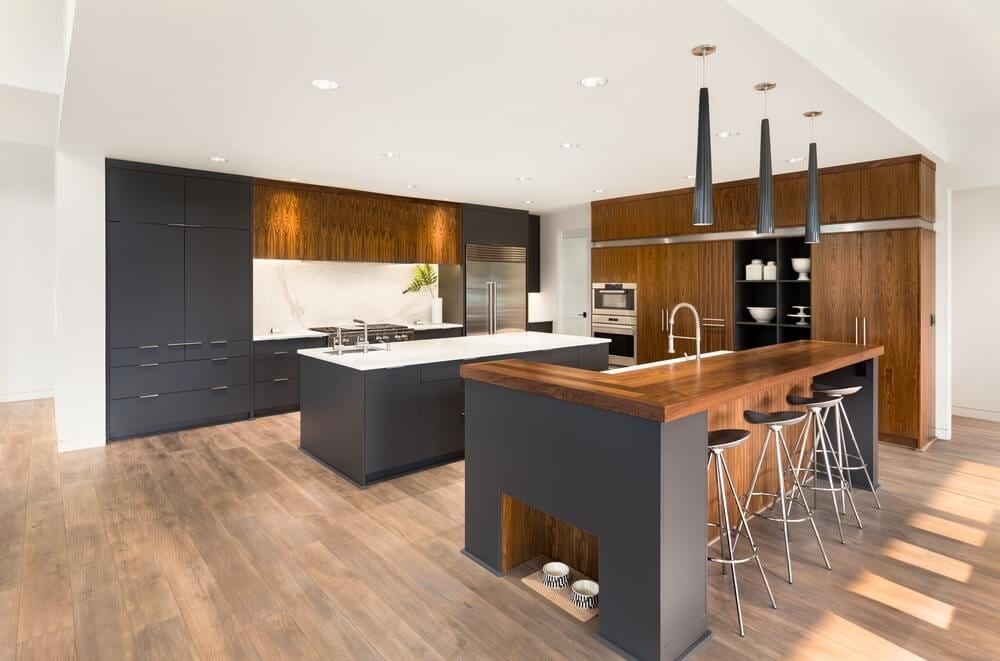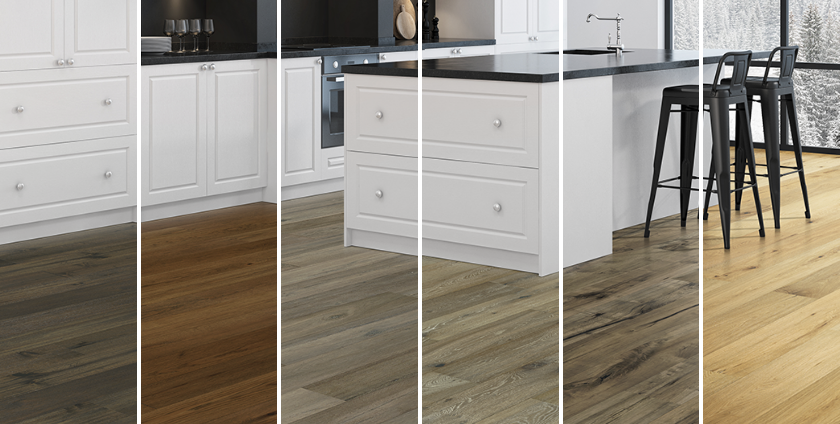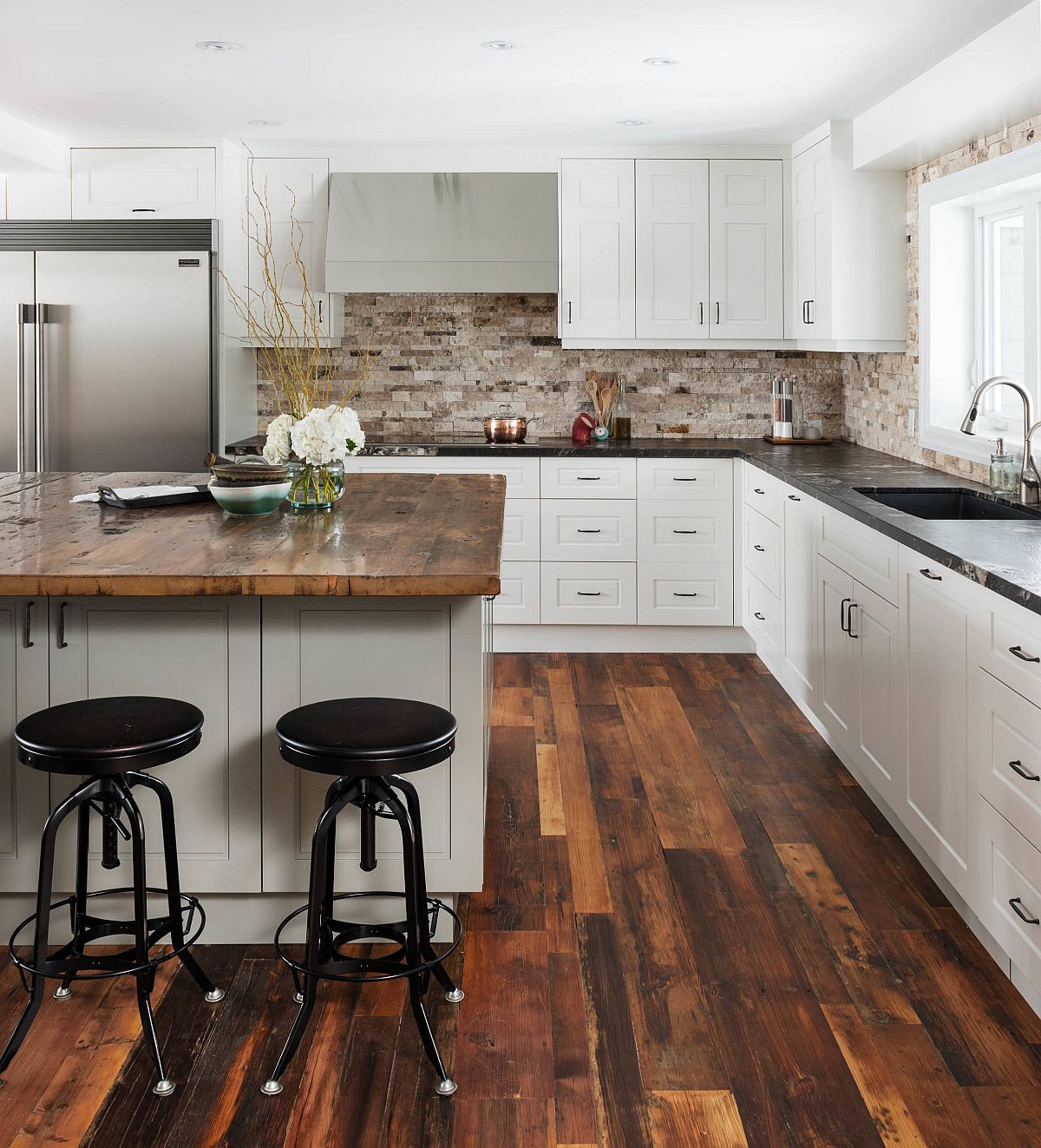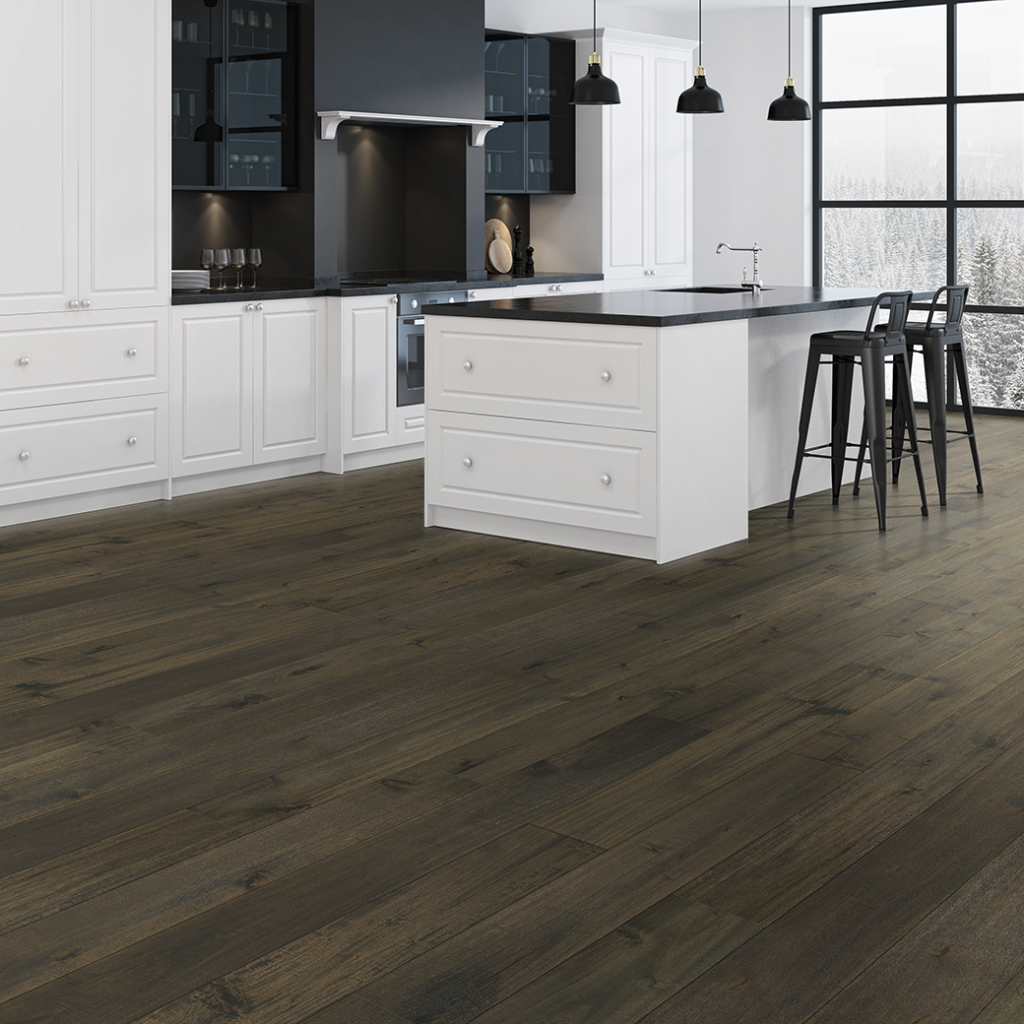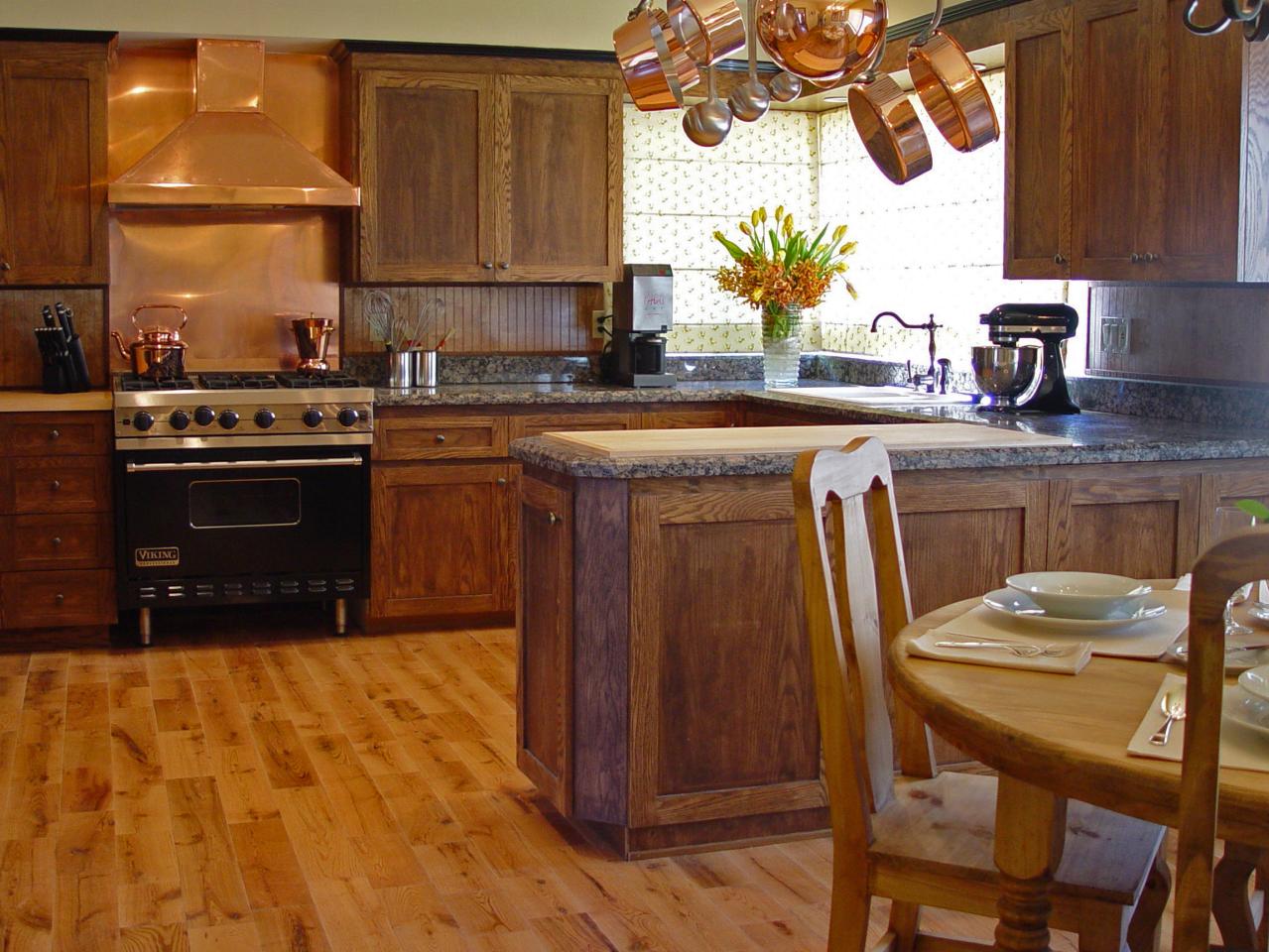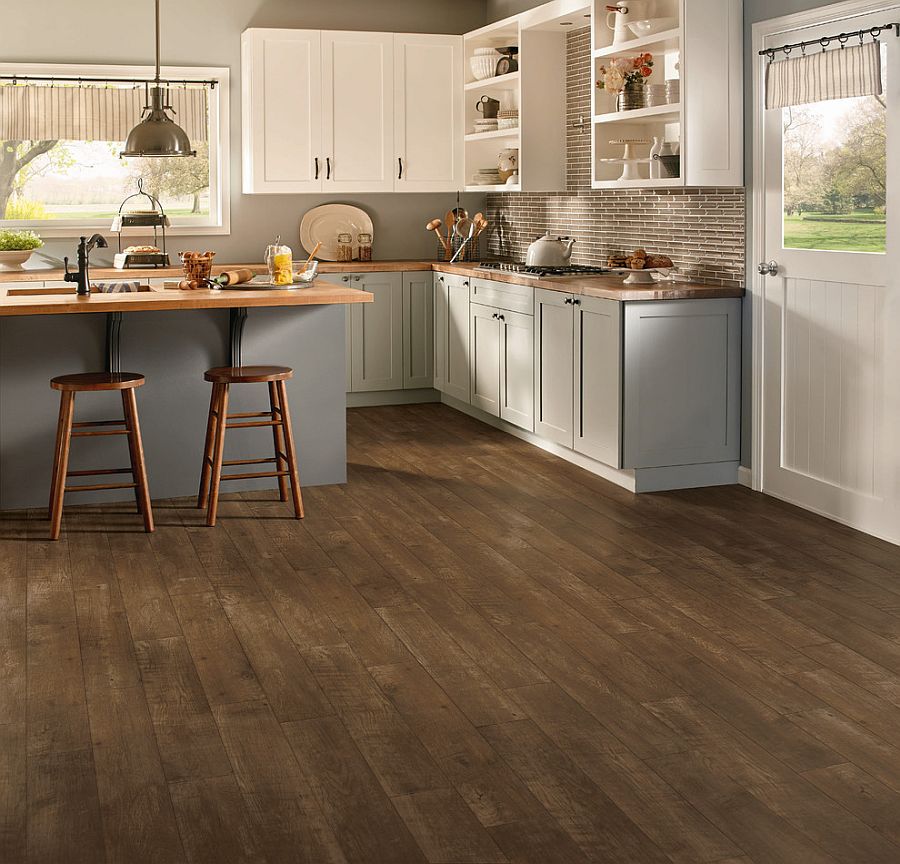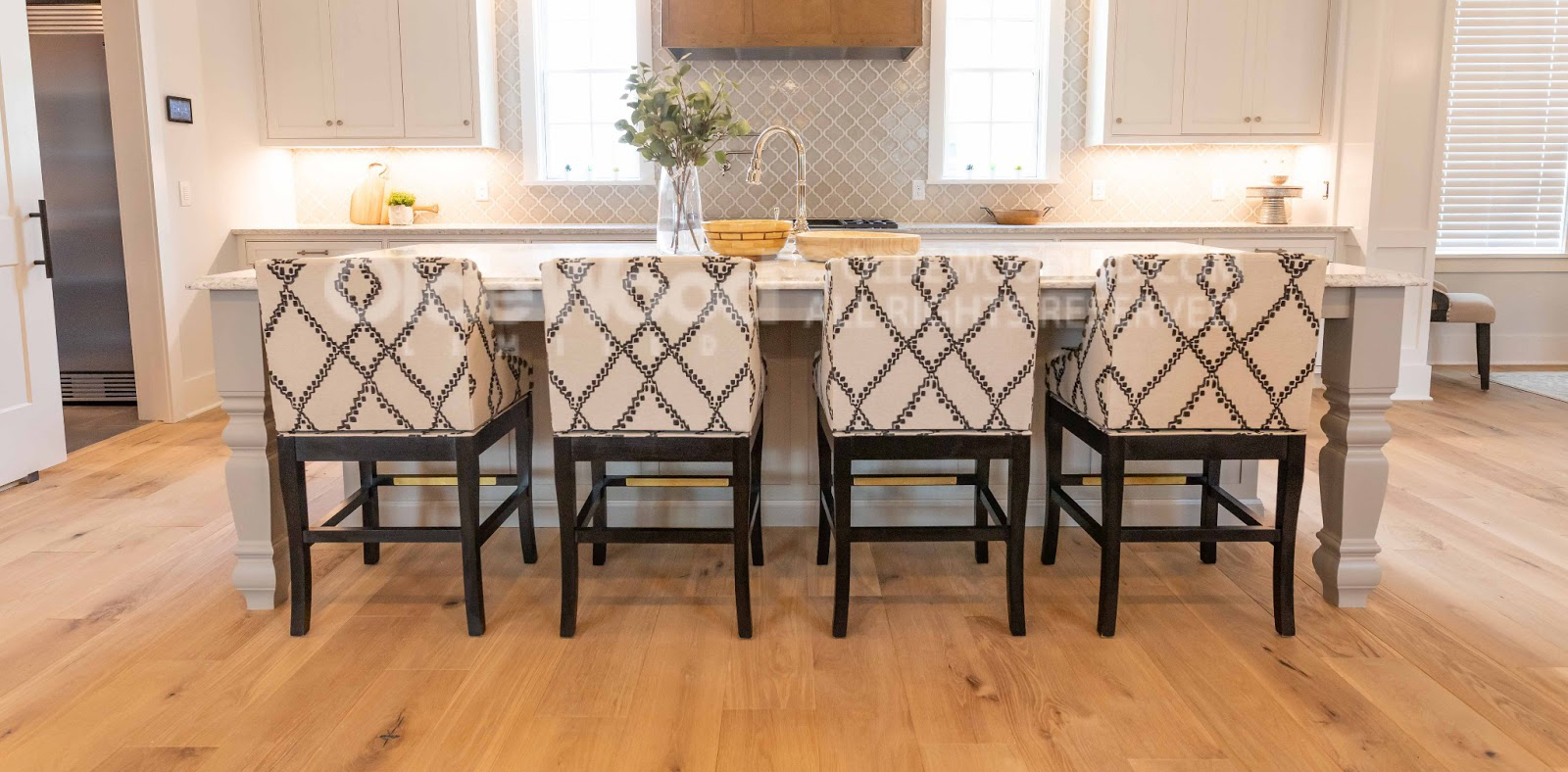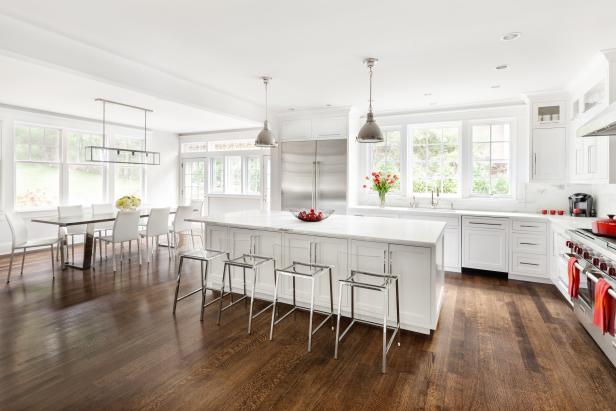Choosing the Right Hardwood Species for Your Kitchen
When I started exploring hardwood flooring options for my kitchen, I quickly realized that choosing the right species was crucial. Each type of wood has its unique characteristics, and finding the perfect match for my kitchen took some careful consideration. Here’s what I discovered about the most popular hardwood species and how to decide which one is right for your kitchen.
- Oak – The Classic Choice: Oak is often the first wood species that comes to mind when thinking about hardwood flooring. Known for its durability and timeless appeal, oak is a versatile choice that can fit into almost any kitchen style, from traditional to modern. I appreciated that oak comes in both red and white varieties, each offering a distinct look. Red oak has a warm, reddish hue with pronounced grain patterns, while white oak is more subdued with a golden tone. Both options are highly resistant to wear and tear, making them ideal for a busy kitchen.
- Maple – Sleek and Modern: If you’re looking for a wood species with a more contemporary feel, maple might be the way to go. Maple hardwood flooring has a smooth, even grain that creates a clean, sleek appearance. I was drawn to its light color, which can help brighten up a kitchen, especially if you have dark cabinets or limited natural light. Maple is also incredibly hard and resistant to scratches, which is a big plus in a high-traffic area like the kitchen. However, its density can make it a bit tricky to stain evenly, so it’s often best left in its natural or lightly stained state.
- Hickory – Rustic and Durable: For a kitchen with a rustic or country vibe, hickory is a fantastic option. Hickory hardwood flooring is known for its dramatic color variations and striking grain patterns, which can add a lot of character to your kitchen. It’s also one of the hardest domestic wood species, making it exceptionally durable and resistant to damage. I loved the idea of hickory for a farmhouse-style kitchen, where the natural beauty of the wood can shine. However, its bold appearance might not be for everyone, so it’s important to consider whether it will complement the overall look of your space.
- Walnut – Rich and Elegant: If you’re after a luxurious, high-end look, walnut hardwood flooring could be the perfect choice. Walnut has a deep, rich color with a smooth, fine grain that exudes elegance. I found that walnut’s dark tones can add warmth and sophistication to a kitchen, especially when paired with lighter cabinets or countertops. While walnut is slightly softer than some other hardwoods, its stunning appearance often outweighs this drawback. Just be mindful that it may show scratches and dents more easily, so it might require a bit more care to maintain its pristine condition.
- Cherry – Warm and Inviting: Cherry hardwood flooring is another excellent option if you’re looking for warmth and character. Cherry wood has a beautiful reddish-brown color that deepens over time, giving your kitchen a warm and inviting atmosphere. I was particularly drawn to its smooth grain and subtle luster, which can add a touch of elegance without being too flashy. While cherry is on the softer side, making it more susceptible to dents, its rich color and natural beauty make it a popular choice for many homeowners.
- Exotic Hardwoods – Unique and Striking: For those who want something truly unique, exotic hardwood species like Brazilian cherry, tigerwood, or mahogany might be worth considering. These woods offer striking colors and patterns that can make a bold statement in your kitchen. I was fascinated by the idea of using an exotic hardwood to create a one-of-a-kind look. However, it’s important to note that these species can be more expensive and harder to source. Additionally, their hardness can make them challenging to work with, so professional installation is often recommended.
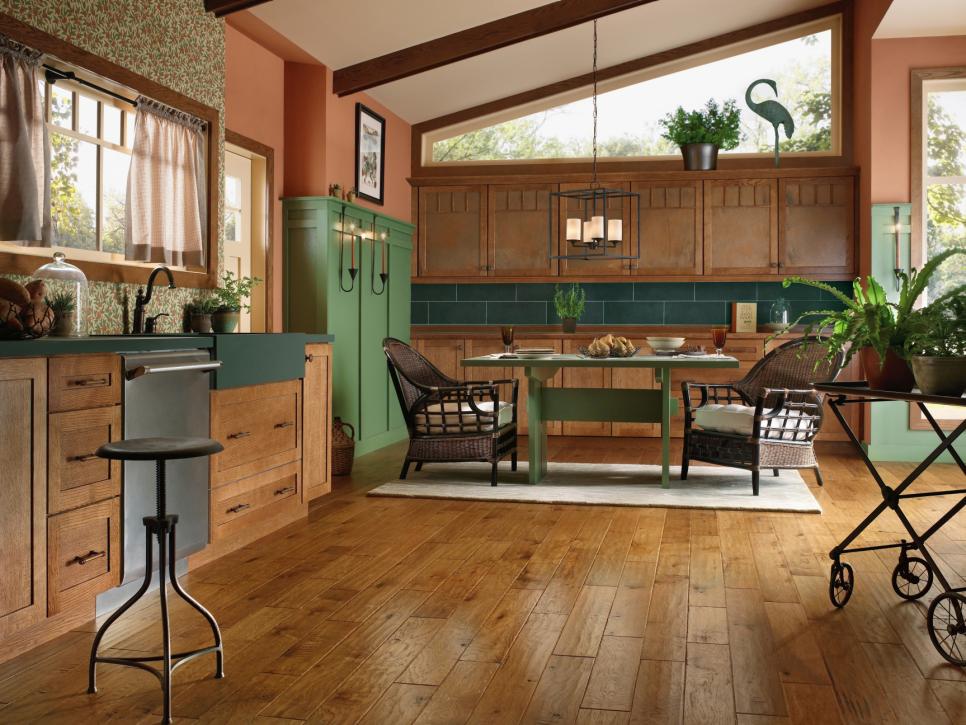
Pros and Cons of Different Hardwood Finishes
Once I settled on the hardwood species for my kitchen, the next step was choosing the right finish. The finish not only enhances the wood’s natural beauty but also plays a crucial role in protecting the floor from daily wear and tear. However, with so many options available, I found it essential to weigh the pros and cons of each finish to make an informed decision. Here’s what I learned about the most common hardwood finishes.
Polyurethane Finish: Durable and Low Maintenance
Polyurethane is one of the most popular hardwood finishes and for a good reason. It forms a tough, protective layer over the wood, making it highly resistant to scratches, stains, and water damage. I appreciated that polyurethane comes in both oil-based and water-based varieties, each with its benefits. Oil-based polyurethane tends to have a warmer, amber tone that enhances the wood’s natural color, while water-based polyurethane is clear and less likely to yellow over time. The durability of this finish makes it ideal for a kitchen, where spills and heavy foot traffic are common. However, polyurethane finishes can be more challenging to touch up if they do get damaged, and they often require a professional application for the best results.
Wax Finish: Natural and Easy to Repair
If you prefer a more natural look and feel for your hardwood floors, a wax finish might be the way to go. Wax penetrates the wood, providing a soft, matte finish that enhances the grain without creating a shiny surface. I was drawn to wax for its ability to give hardwood floors a warm, inviting appearance. One of the biggest advantages of wax is that it’s easy to touch up or reapply, which means you can keep your floors looking fresh without a complete refinishing job. However, wax finishes are less durable than polyurethane and require regular maintenance, including periodic re-waxing and buffing. They’re also more susceptible to water damage, so spills need to be cleaned up promptly.
Penetrating Oil Finish: Enhancing Natural Beauty
Penetrating oil finishes, such as tung oil or linseed oil, are another option for those who want to enhance the natural beauty of their hardwood floors. These oils soak into the wood, bringing out the richness of the grain while providing a low-sheen finish. I loved the idea of using a penetrating oil for its ability to give the floor a more organic, hand-rubbed appearance. The finish is relatively easy to apply and maintain, and it can be refreshed with additional coats of oil over time. However, like wax, penetrating oil finishes offer less protection against scratches and stains compared to polyurethane, and they may require more frequent reapplication, especially in high-traffic areas like the kitchen.
Aluminum Oxide Finish: Superior Durability
For those looking for the ultimate in durability, an aluminum oxide finish is hard to beat. This finish is often used in pre-finished hardwood flooring and provides an extremely tough, scratch-resistant surface. I found that aluminum oxide finishes are particularly well-suited for kitchens, where the floor is exposed to constant wear and tear. The finish can last for years without showing signs of wear, making it a low-maintenance option. However, the downside is that aluminum oxide finishes can be difficult to refinish or repair if they do get damaged, and they tend to have a slightly shinier appearance, which may not be to everyone’s taste.
Acid-Cured Finish: High-Gloss and Resilient
Acid-cured finishes, also known as Swedish finishes, are known for their durability and high-gloss appearance. This type of finish is often used on exotic hardwoods or floors with intricate patterns, as it enhances the wood’s natural color and provides a glass-like sheen. I considered an acid-cured finish for its resilience to scratches and chemicals, making it a good choice for a busy kitchen. However, this finish is also one of the most challenging to apply, requiring professional installation and adequate ventilation due to its strong fumes. Additionally, it can be difficult to repair if damaged, so it may not be the best choice if you anticipate needing to touch up your floors frequently.
Shellac Finish: Vintage Appeal
Shellac is a traditional finish that has been used for centuries, particularly in older homes. It provides a warm, amber tone that can give hardwood floors a vintage or antique look. I was intrigued by shellac for its ability to create a rich, glossy finish that’s easy to apply and dries quickly. However, shellac is less durable than modern finishes and can be damaged by water or alcohol, which are common in a kitchen. It’s also prone to chipping or cracking, so it might not be the best choice for a floor that will see a lot of use. Despite these drawbacks, shellac can be a great option if you’re looking to restore an older floor or achieve a specific historical look.
How to Combine Hardwood Flooring with Kitchen Cabinets
One of the most exciting parts of designing my kitchen was finding the perfect balance between the hardwood flooring and the kitchen cabinets. The combination of these two elements can set the tone for the entire space, so it’s essential to get it right. I spent a lot of time experimenting with different pairings, and here are some tips I found helpful for creating a harmonious and stylish look.
Matching Tones for a Cohesive Look
If you prefer a seamless and unified appearance in your kitchen, matching the tones of your hardwood flooring with your cabinets is a great approach. I found that using similar colors creates a cohesive look that can make the space feel larger and more open. For example, if you choose a warm oak floor, pairing it with cabinets in a similar tone can create a harmonious flow throughout the kitchen. This approach works particularly well in smaller kitchens, where consistency in color can help avoid a cluttered look. However, it’s important to ensure that the tones are not too similar, as this can result in a monotone appearance. A slight variation in shade or finish can add just enough contrast to keep things interesting.
Contrasting Colors for Visual Interest
For those who want to make a bold statement, contrasting the color of your hardwood flooring with your kitchen cabinets can create a striking effect. I was intrigued by the idea of using a dark walnut floor with light-colored cabinets, or vice versa. The contrast adds depth and dimension to the kitchen, making each element stand out. This approach works especially well in larger kitchens, where the contrast can help define different areas of the space. However, achieving the right balance is key—too much contrast can be overwhelming, while too little can make the space feel disjointed. I found that incorporating complementary elements, such as a matching backsplash or countertop, can help tie the look together.
Mixing Materials for a Unique Look
Another way to combine hardwood flooring with kitchen cabinets is by mixing materials and textures. I loved the idea of pairing a rustic, distressed wood floor with sleek, modern cabinets. The combination of rough and smooth surfaces adds a unique and eclectic vibe to the kitchen. This approach allows for more creativity and personalization, as you can experiment with different finishes, colors, and styles. For example, combining a reclaimed wood floor with glossy, lacquered cabinets can create a striking contrast that feels both modern and timeless. The key is to find a common thread, such as a color or material, that ties the elements together and creates a cohesive look.
Considering the Undertones
One of the most important lessons I learned when combining hardwood flooring with kitchen cabinets is the importance of considering undertones. Even if the colors seem to match at first glance, different undertones can clash and create an unbalanced look. For example, a floor with cool, gray undertones might not pair well with cabinets that have warm, yellow undertones. I found it helpful to bring samples of both the flooring and cabinet materials into the space to see how they look under the lighting conditions in my kitchen. This way, I could ensure that the undertones were complementary and created a harmonious overall effect.
Playing with Finishes
The finish of both the hardwood flooring and the kitchen cabinets can also play a significant role in the overall look of the kitchen. I experimented with different finishes, such as matte, satin, and glossy, to see how they interacted with each other. A matte floor paired with glossy cabinets can create an interesting contrast in texture, while a satin finish on both elements can result in a more understated and elegant look. It’s important to consider how the finishes will affect the maintenance and durability of the materials as well. For example, a high-gloss finish on cabinets might show fingerprints more easily, while a matte floor might be more forgiving of scratches.
Incorporating Color Accents
To further enhance the combination of hardwood flooring and kitchen cabinets, I found that incorporating color accents can add a touch of personality and style to the space. Whether through a bold backsplash, colorful appliances, or decorative elements like rugs and curtains, these accents can help tie the design together and create a cohesive look. I loved the idea of using a pop of color that complements both the flooring and cabinets, creating a focal point that draws the eye. This approach allows for flexibility, as you can change the color accents over time to refresh the look of your kitchen without having to replace the flooring or cabinets.
Durability and Maintenance Tips for Kitchen Hardwood Floors
When I decided to install hardwood floors in my kitchen, I knew that durability and maintenance would be key factors in ensuring they stayed beautiful over time. Kitchens are high-traffic areas, and the constant exposure to spills, moisture, and heavy use can take a toll on hardwood floors if they’re not properly cared for. Here are some of the tips and strategies I’ve found helpful for keeping my kitchen hardwood floors looking new and extending their lifespan.
Choose the Right Finish for Durability
One of the first steps in ensuring the durability of your kitchen hardwood floors is choosing the right finish. As I mentioned earlier, polyurethane finishes are highly durable and resistant to water, scratches, and stains, making them an excellent choice for kitchens. I opted for a water-based polyurethane finish because it’s not only tough but also less likely to yellow over time, keeping the wood’s color true. If you’re looking for maximum durability, consider a finish with aluminum oxide, which offers superior protection and longevity. The right finish will act as a barrier against everyday wear and tear, so it’s worth investing in a high-quality product.
Protecting Your Floors from Water Damage
Water is one of the biggest threats to hardwood floors, especially in a kitchen where spills and splashes are inevitable. I’ve made it a habit to wipe up any spills immediately to prevent water from seeping into the wood and causing damage. Using mats or rugs in high-risk areas, such as in front of the sink or dishwasher, can also help protect the floor from water exposure. Additionally, I’ve found that placing a tray under pet water bowls and using drip trays for plants are simple ways to minimize the risk of water damage. It’s also important to keep an eye out for any leaks or plumbing issues and address them promptly to avoid long-term damage.
Regular Cleaning and Maintenance
Regular cleaning is essential for maintaining the beauty and longevity of hardwood floors. I use a soft-bristle broom or a vacuum with a hardwood floor attachment to remove dirt and debris daily. This helps prevent scratches caused by grit or small stones that might get tracked into the kitchen. For deeper cleaning, I rely on a damp (not wet) microfiber mop and a hardwood floor cleaner that’s safe for the finish. It’s important to avoid using harsh chemicals, abrasive cleaners, or steam mops, as these can damage the finish and the wood itself. Regular dusting and cleaning not only keep the floors looking great but also help preserve their finish.
Using Furniture Pads and Area Rugs
One of the simplest ways to protect your hardwood floors from scratches and dents is by using furniture pads under the legs of tables, chairs, and other heavy kitchen furniture. I’ve found that felt pads work well and are easy to apply. They prevent the furniture from scratching the floor when moved and help distribute the weight more evenly. Additionally, I’ve placed area rugs in high-traffic areas, such as in front of the stove and sink, to reduce wear and tear on the floor. Rugs not only add a layer of protection but also enhance the kitchen’s decor. Just make sure to use non-slip rug pads to prevent the rugs from sliding and causing accidents.
Refinishing and Repairing
Even with the best care, hardwood floors may eventually show signs of wear, such as scratches, dullness, or minor dents. Refinishing the floors is a great way to restore their original beauty and extend their life. I’ve learned that it’s possible to sand down the top layer of the floor and apply a new finish, giving it a fresh, new look. The frequency of refinishing depends on the level of wear and the thickness of the wood, but it’s generally recommended every 7-10 years for high-traffic areas like the kitchen. For smaller scratches or dents, wood filler, and touch-up kits can be used to repair the damage without needing a full refinishing job.
Controlling Humidity Levels
Maintaining the right humidity levels in your home is crucial for the longevity of hardwood floors. Wood is a natural material that expands and contracts with changes in humidity, which can lead to gaps, warping, or cupping over time. I’ve found that keeping indoor humidity levels between 35% and 55% helps prevent these issues. In the winter, when indoor air tends to be dry, using a humidifier can help maintain the right moisture levels in the wood. Conversely, in the summer, a dehumidifier or air conditioning can reduce excess humidity and prevent the wood from swelling. By controlling humidity, you can protect your hardwood floors from seasonal changes and ensure they stay in great condition.
Eco-Friendly Hardwood Flooring Options for Your Kitchen
As someone who cares about the environment, finding eco-friendly hardwood flooring options for my kitchen was a top priority. I wanted to ensure that the materials I chose were sustainable and had a minimal impact on the planet. After doing some research, I discovered several eco-friendly hardwood flooring options that offer both beauty and environmental responsibility. Here’s what I found.
FSC-Certified Wood
One of the best ways to ensure that your hardwood flooring is eco-friendly is by choosing wood that is certified by the Forest Stewardship Council (FSC). FSC certification guarantees that the wood comes from responsibly managed forests that meet high environmental and social standards. I was pleased to find that many hardwood species, including oak, maple, and cherry, are available with FSC certification. This means that the wood is harvested in a way that protects biodiversity, prevents deforestation, and supports the rights of indigenous communities. By choosing FSC-certified wood, I felt confident that my flooring choice was contributing to sustainable forestry practices.
Reclaimed Wood
Reclaimed wood is another excellent eco-friendly option for hardwood flooring. This wood is sourced from old buildings, barns, or other structures that are being dismantled, giving the wood a second life. I was drawn to the idea of using reclaimed wood for its unique character and history. Each plank has its own story, with weathered textures and rich patinas that can add warmth and authenticity to a kitchen. Reclaimed wood not only reduces the demand for new timber but also prevents valuable materials from ending up in landfills. It’s a sustainable choice that also adds a lot of charm and personality to your home.
Bamboo Flooring
Although not technically a hardwood, bamboo is a popular alternative that offers many of the same benefits while being more eco-friendly. Bamboo is a fast-growing grass that can be harvested every 5-7 years, making it a highly renewable resource. I was impressed by the durability and hardness of bamboo flooring, which can be comparable to traditional hardwoods like oak or maple. Bamboo also has a modern, sleek appearance that works well in contemporary kitchen designs. However, it’s important to choose bamboo products that are certified by the FSC or another reputable organization, as some bamboo farming practices can be harmful to the environment.
Cork Flooring
Cork is another eco-friendly flooring option that I considered for my kitchen. Cork is harvested from the bark of cork oak trees, which can be done without harming the tree itself. This makes cork a renewable and sustainable material. I loved the idea of using cork flooring for its softness and comfort underfoot, which is a big plus in a kitchen where you spend a lot of time standing. Cork also has natural insulating properties, providing both soundproofing and temperature regulation. Additionally, cork is resistant to mold, mildew, and pests, making it a healthy choice for the home. Like bamboo, it’s important to choose cork products that are sustainably harvested and free from harmful chemicals.
Low-VOC Finishes and Adhesives
When choosing eco-friendly hardwood flooring, it’s also important to consider the finishes and adhesives used during installation. Many traditional finishes and adhesives contain volatile organic compounds (VOCs), which can off-gas harmful chemicals into your home’s air. I made sure to select low-VOC or zero-VOC finishes and adhesives for my kitchen flooring. These products are better for indoor air quality and have a lower environmental impact. There are now many eco-friendly options available that don’t compromise on durability or appearance, so it’s easier than ever to find products that are both safe and sustainable.
Engineered Hardwood with Sustainable Practices
If you’re considering engineered hardwood for your kitchen, it’s possible to find eco-friendly options by looking for products made with sustainable practices. Engineered hardwood consists of a thin layer of hardwood on top of a plywood or high-density fiberboard (HDF) core. I found that choosing engineered hardwood made from FSC-certified wood and low-VOC adhesives can be a more sustainable option than traditional hardwood, as it uses less solid wood overall. Some manufacturers also use recycled or reclaimed wood in the core layers, further reducing the environmental impact. Engineered hardwood is also more stable and less prone to warping, making it a practical choice for kitchens.
Kitchen Flooring Essentials
Kitchen Flooring Ideas (Most Popular) – Designing Idea
Hottest Trending Kitchen Floor
Our Top Picks for Wood Floors in the Kitchen Olde Wood Ltd.
Hardwood Kitchen Floor Ideas
Beautiful Wood Floors In The Kitchen
Related Posts:
